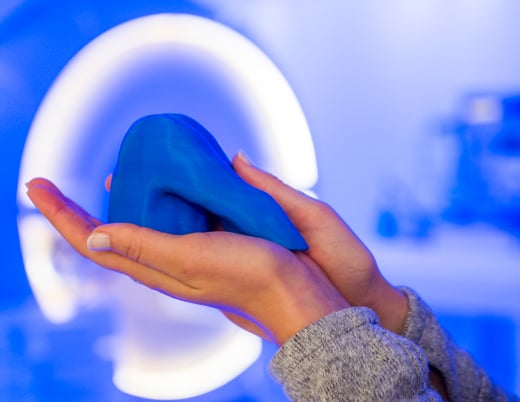Can a symptom assessment tool help pediatric providers and parents improve care for medically complex children?
Caring for children with severe neurological impairments is incredibly complex partly due to polypharmacy — the simultaneous use of drugs to treat one or multiple medical conditions. Some parents are tasked with administering between 30 to 50 doses of medicine over a 24-hour period. Clinically, there isn’t an efficient or standard way for pediatric providers to identify and track the symptom changes that patients experience when their medications are switched or dosing is altered. Using geriatric, palliative care, and oncologic literature as a starting point, special needs pediatrician and clinical researcher James Feinstein, MD, MPH, is leading the development of a tool that seeks to help providers optimize medication regimens to make them safer for patients and easier for caregivers to monitor.
Patients with severe neurological impairments may, for example, have intractable seizure disorders, require medical technology like gastrostomy tubes or ventilators, and be nonverbal or lack the ability to communicate at all. Most of these patients rely completely on their parents to provide their home medical care and interface with their medical teams. While children with neurological impairments comprise a small percentage of the pediatric patient population, they have the highest rates of hospitalization and require numerous visits to a variety of subspecialty doctors who help manage specific aspects of their care.
Addressing clinical concerns during visits
In a typical 40-minute visit for one of these complex patients, a physician and the parent must address a multitude of clinical concerns and issues. While physicians are very good at reviewing important medical symptoms like pain, headaches, seizures, Dr. Feinstein has found that there are many noteworthy symptoms that may never be broached in an appointment and routinely go unnoticed.
“Insomnia, nausea, constipation, sweating, dry mouth, irritability,” he says. “These are all important symptoms that patients frequently experience and can be a consequence of their medications. But we may overlook these less severe symptoms — and a parent might not think to bring them up — because we’re focused on a variety of competing issues that we need to address.”
That can ultimately create myriad problems for the patient and their family. In the short term, persistent symptoms can significantly affect quality of life. When left untreated, symptoms can culminate into expensive and potentially dangerous emergency care further down the line — care that can likely be circumvented if physicians are equipped to notice and address concerns at the optimal time.
Tracking the symptoms of polypharmacy
Funded over a five-year period by the NIH’s National Institute for Child Health and Human Development, Dr. Feinstein is studying ways to measure and track these symptoms. For a clinician to do this effectively, he says, they need to be able to do to a few things well:
- recognize that a problematic symptom exists
- assess a child’s regimen to see if there are current medications that address that symptom or contribute to it
- intervene to alleviate the problematic symptom
That’s a near impossible task if a clinician doesn’t have an easy, efficient way to look at the information holistically. So, Dr. Feinstein’s ultimate goal is to implement a standardized system that collects symptom data from parents about their children in a way that’s meaningful for clinicians to use. Interestingly, he found he didn’t need to start completely from scratch.
“The medical concerns these children face — complex diagnoses, medical frailty, polypharmacy — are not unlike the geriatric patient population,” says Dr. Feinstein. “We have lessons to learn from our geriatric colleagues, who do a very good job of supervising complex polypharmacy regimens. There are quite a few existing practices that we can adapt for children.”
A comprehensive review of geriatric, oncologic and palliative care literature helped Dr. Feinstein and team modify a symptom inventory containing 28 symptoms so that it could be answered by parents of children with medical complexity. From there, they developed a symptom assessment tool, an online questionnaire that parents can quickly fill out at home prior to their child’s hospital appointment. In addition to simply recording the existence of a symptom, the survey solicits information on the symptom frequency and its effect on daily life for the parent and the patient.
Building Epic efficiencies
Initially, the data were captured through individual REDcap survey links manually generated by a medical team member prior to each appointment, and results were merged with clinical and pharmacy data. That was cumbersome, so Dr. Feinstein worked with the Children’s Colorado medical record vendor, Epic, to build the tool into the patient’s healthcare portal, MyChart. Migrating the tool into Epic allows the team to build in efficiencies and create comprehensive data visualizations.
Before a clinical visit, parents now receive an automated message and an alert in MyChart to complete the questionnaire. Even better, because the geriatric, oncologic and palliative care literature had outlined strategies for score summarization, Dr. Feinstein and Epic modified them to create composite scores — single numbers that show how much a given symptom is affecting a patient. That information is also presented graphically, allowing clinicians to see symptom trajectories over a period of many months. The tool is still in research mode, so clinicians can’t use the data quite yet, but what Dr. Feinstein sees is promising.
Knowing the score
In a recent paper published in JAMA Pediatrics and JAMA Network Open, Dr. Feinstein and his team sought to study the significance of the composite scores. Notably, out of a cohort of 100 children with severe neurological impairment, 54% of parents reported that their child was experiencing pain while in their baseline usual state of health. “That’s surprisingly high,” says Dr. Feinstein. When they looked at the composite measures for each child and the pain medication each was on, only 61% of children with reported pain were on a prescribed pain medication.
“This immediately focuses the questions we should be asking related to that symptom,” he says, “which are: Why is this child still having pain? Do we have opportunities to adjust the existing pain regimens by changing or adding a medication? Does this signal an opportunity to treat pain with a different modality? Or, has the symptom trajectory changed enough that we need to look for a new underlying cause before we treat it? That’s what these data can highlight, not just for pain, but for 28 important symptoms.”
After that study was published, Dr. Feinstein received communications from pharmaceutical companies who were interested in using the tool and wanted to know when it would be ready. The FDA encourages clinical trials to provide patient reported outcomes (PRO) measures, yet there are very few validated pediatric tools in the market as comprehensive as Dr. Feinstein’s.
“To be able to use it as an outcome measure to evaluate new drugs that are coming down the pipeline for rare diseases would be incredible,” he says. “It’s also a tool that’s broadly applicable for a variety of patient populations, not necessarily just for children with neurological impairment. I think there would be tremendous value in tracking standardized symptom sets for complex patients with other underlying conditions, like solid organ transplant recipients.”
Giving a voice
For now, though, Dr. Feinstein and team are still working to document the comprehensive benefits of the tool by enrolling children longitudinally and implementing proactive study methods. For instance, they’ve set up a system where Epic produces a daily report of medication changes with a significant side effect profile — like anti-epileptic drugs or those that affect the central nervous system. When there’s a change, it automatically sends that patient’s parent a survey and will do so again at three days, at one week, at three weeks. They’re looking to proactively capture changes in symptoms that might signal a response to that medication.
Work also continues with Epic to refine the graphical presentations. Dr. Feinstein says they’re experimenting with assembling related symptoms into subgroups and designing meaningful ways to present those insights. “A standardized tool like this has the potential to increase clinicians’ efficiency and ultimately be more useful than relying on our typical process of cherry-picking what specific symptoms to ask about,” he says. “Each of us focus on the symptoms that are important to the immediate issues at hand, but if the information isn’t structured, you can’t compare symptoms over time to another clinician’s assessment. This can make it difficult to assess, coordinate and refine a child’s care plan.”
For children who cannot self-report symptoms, a parent-reported survey coupled with medication data will help clinicians better identify targets for personalized symptoms management. Most importantly, it gives parents a voice. “Parents have expressed that they really appreciate being able to provide these symptom data in a low-stress manner before a visit,” says Dr. Feinstein. “These parents already have so much on their plates, so this tool provides an easy — yet comprehensive and effective — way for parents to report pertinent symptom information that can help optimize their child’s care.”
Featured Researchers

James Feinstein, MD, MPH/MSPH
Attending physician
Special Care Clinic and Child Health Clinic
Children's Hospital Colorado
Associate professor
Pediatrics-General Pediatrics
University of Colorado School of Medicine





 720-777-0123
720-777-0123










